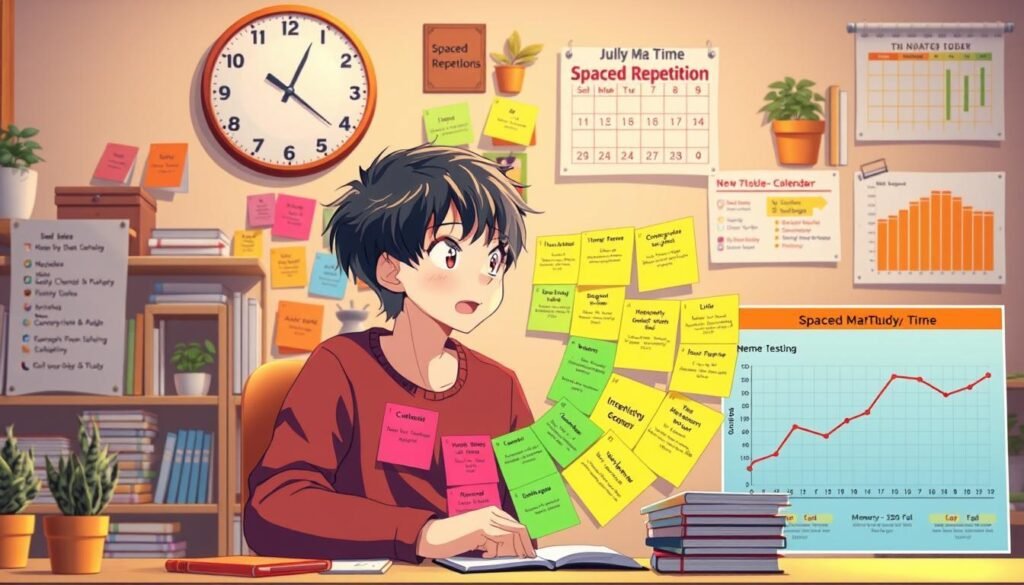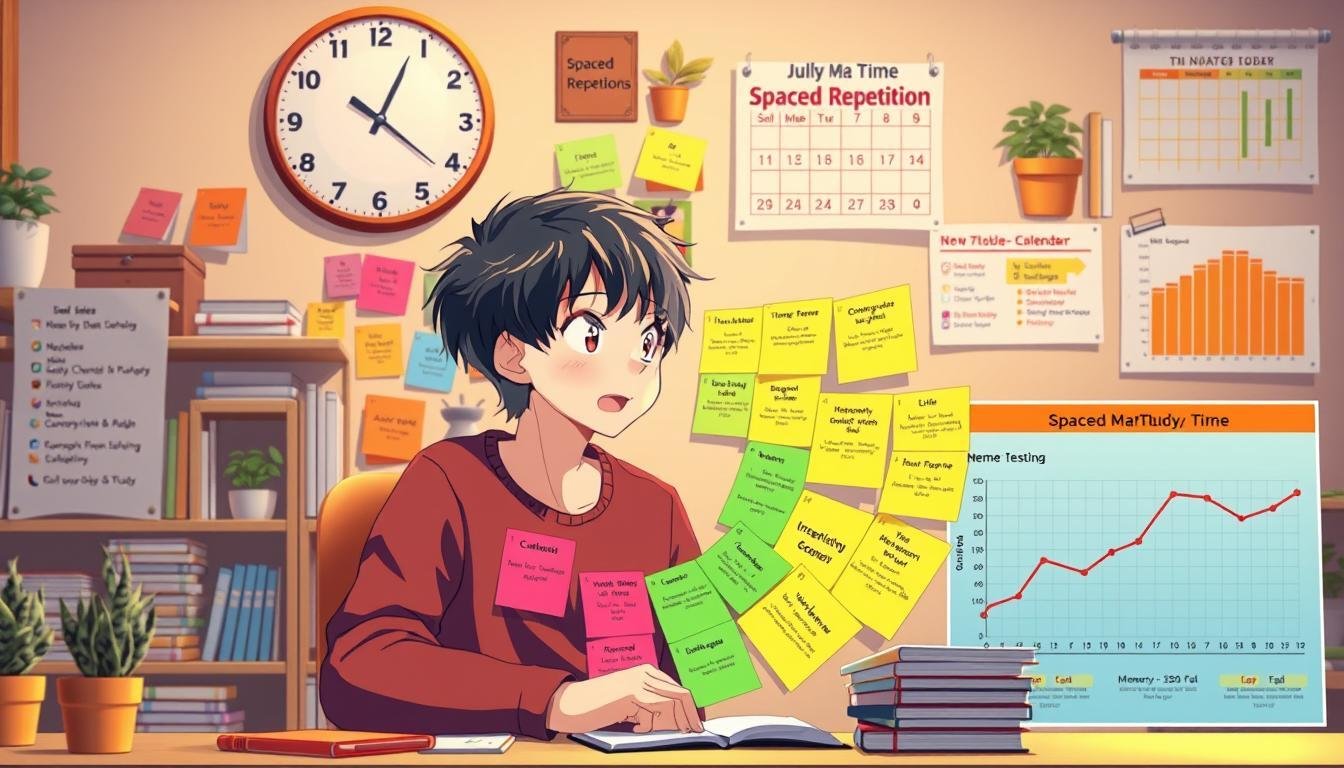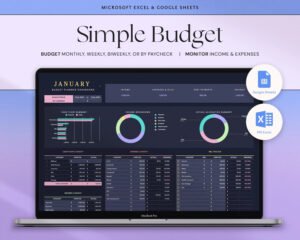What if you could find ways to do well in school without feeling too stressed? There are study hacks that can help you stay on top of your work. These tips can make learning easier in today’s fast world.
Imagine being able to learn and remember hard stuff easily. Simple study hacks can help you do this. By using these tips every day, you can work better and feel less stressed. So, what are the best study hacks for students to stay ahead?
Table of Contents

Key Takeaways
- Discover the top 10 study hacks to improve your learning efficiency
- Learn how to apply effective study tips to reduce stress and boost productivity
- Understand the importance of using proven study hacks for students in today’s educational environment
- Find out how to stay organized and focused with the right study hacks
- Get ready to achieve academic success with these simple yet powerful study tips
The Science Behind Effective Study Hacks for Students
Unlocking the power of study hacks starts with knowing how our brains learn. By using how our minds pick up info, students can remember and understand better.
Understanding How Your Brain Learns
The brain learns best when it’s active and repeats what it learns. Methods like spaced repetition and active recall work well. They help make memories stronger.
The Role of Neuroscience in Learning
Neuroscience shows that our brains can change and adapt. Study hacks that mix things up can help our brains learn better.
Why Traditional Study Methods Often Fail
Old ways like just reading and memorizing don’t really get the brain going. New study tips that make you do things can help a lot.
| Traditional Methods | Effective Study Hacks |
|---|---|
| Passive Reading | Active Recall |
| Rote Memorization | Spaced Repetition |
| Single-Session Studying | Distributed Practice |
The Pomodoro Technique: Maximizing Focus and Productivity
The Pomodoro Technique is a great study hack for students. It helps you focus better and work more efficiently. It breaks your study time into short, easy-to-handle chunks.


It works like this: study for 25 minutes, then take a 5-minute break. After four of these, you get a longer break of 15-30 minutes. This makes studying feel less hard and more organized.
Using the Pomodoro Technique has many good points:
- Improved concentration during study times.
- Reduced mental fatigue with regular breaks.
- Enhanced time management skills.
Here’s how to start:
- Choose a task to focus on.
- Set a timer for 25 minutes.
- Work on the task until the timer rings.
- Take a 5-minute break.
- After four cycles, take a longer break.
Adding the Pomodoro Technique to your study routine can make your studying better. You’ll get better grades and feel more focused.
Active Recall: Transform Passive Reading into Dynamic Learning
Active recall is a great study trick. It makes reading active and fun. By trying to remember what you read, you learn more and remember better.
Implementation Strategies for Active Recall
Here are ways to add active recall to your study routine:
- Flashcards: Make flashcards with questions on one side and answers on the other. This tests your knowledge.
- Self-Quizzing: Test yourself on the material often, without looking at your notes.
- Teaching: Teach what you’ve learned to someone else. This helps you understand it better.
Digital Tools for Active Recall Practice
Use digital tools to make active recall easier:
- Anki: A flashcard app that helps you remember better with spaced repetition.
- Quizlet: Make and use flashcards and quizzes to learn actively.
- Brainscape: Smart flashcards that adjust to how fast you learn.
Common Active Recall Mistakes to Avoid
Don’t make these mistakes to get the most from active recall:
- Passive Review: Just reading your notes over and over without testing yourself.
- Inconsistent Practice: Not doing active recall often makes it less helpful.
- Overloading Information: Trying to remember too much at once doesn’t work well.
| Strategy | Benefit |
|---|---|
| Flashcards | Improves memory with active recall and spaced repetition. |
| Self-Quizzing | Finds what you don’t know and makes learning stick. |
| Teaching | Makes you understand better by explaining what you’ve learned. |
Mind Mapping: Visualize and Connect Complex Information
Mind mapping is a great study hack for students. It changes how you organize info. It makes complex topics easier to understand and remember.

Using mind maps breaks down big subjects into smaller parts. It shows how ideas are connected. This makes studying more efficient and effective.
Here are some study tips for making good mind maps:
- Start with a central idea in the middle of the page.
- Branch out with related subtopics and use keywords.
- Incorporate colors and images to make the map engaging.
- Use digital tools like MindMeister or create them by hand for flexibility.
Mind mapping is great for brainstorming essays, planning projects, and studying for exams. It helps you see information better. This makes your study time more productive.
Spaced Repetition: The Key to Long-Term Memory Retention
Spaced repetition is a great study trick. It helps you remember things for a long time. By studying at different times, you keep your memory sharp.

Creating Your Spaced Repetition Schedule
Begin by studying new stuff right after you learn it. Then, wait a bit longer before studying it again. Here’s a simple plan:
- Day 1: Initial study
- Day 3: First review
- Day 7: Second review
- Day 14: Third review
Digital Apps for Spaced Repetition
Use apps to make studying easier. Tools like Anki and Quizlet help plan your study sessions. This keeps you on track.
Combining Spaced Repetition with Other Techniques
Make your studying better by mixing it up. Try active recall during each study session. This helps you understand and remember more.
The Environment Hack: Creating Your Optimal Study Space
Changing your study area is a great study hack. A neat space helps you focus and enjoy studying more. Start with good lighting. Natural light is best, but bright, white lamps work too.
It’s important to control noise levels. Some like it quiet, others like background sounds. Use noise-cancelling headphones or soft music to set the mood.
Being comfortable is key, so think about ergonomics. Get a good chair and desk for long study times. Keep your space organized to avoid distractions. Use shelves and planners to stay tidy.
Different places need different setups. In libraries, find quiet spots and use resources. Coffee shops are cozy with sounds that spark creativity. Dorm rooms can be made inspiring with decor.

| Factor | Library | Coffee Shop | Dorm Room |
|---|---|---|---|
| Lighting | Ample natural and artificial lighting | Mixed lighting with warm tones | Customizable based on preference |
| Noise Level | Very quiet | Ambient noise | Variable |
| Ergonomics | Standard furniture available | Informal seating options | Depends on personal setup |
| Organization | Structured and organized | Casual and flexible | Personalized and customizable |
Memory Palace Technique: Building Mental Information Structures
The Memory Palace technique is a great study hack. It helps you organize and remember information easily. You link info to places in your mind, making it easier to recall.
Steps to Create Your First Memory Palace
- Choose a Familiar Location: Pick a place you know well, like your home or school.
- Identify Distinct Areas: Break the location into specific sections or rooms.
- Associate Information: Link each piece of information you need to remember with a particular spot in your chosen location.
- Visualize Vividly: Create strong, memorable images for each association to enhance recall.
- Review Regularly: Walk through your Memory Palace frequently to reinforce the associations.
Advanced Memory Palace Applications
Once you get the hang of it, you can use the Memory Palace for tough subjects:
| Application | Description |
|---|---|
| Language Learning | Associate vocabulary words with locations to enhance language acquisition. |
| Exam Preparation | Organize and retain large volumes of information for exams. |
| Public Speaking | Remember key points and speeches by placing them in your Memory Palace. |
| Project Management | Track project milestones and tasks by associating them with different areas. |
Using the Memory Palace in your studies can change how you learn. It’s a powerful tool for remembering things. Try it out and see how it helps you in school.
Body-Mind Connection: Physical Preparation for Better Learning
Taking care of your body can make you study better. Using the right study tips gets your brain ready to learn.
Pre-study Nutrition Tips
Eating the right foods can help you focus and remember better. Try these snacks:
- Blueberries: Full of antioxidants.
- Almonds: Good for healthy fats.
- Dark chocolate: Makes you feel good and focused.
Exercise and Learning Enhancement
Exercising regularly makes you healthier and smarter. Here’s why:
- It makes blood flow to your brain.
- It lowers stress.
- It makes you think better.
Sleep Optimization for Better Retention
Good sleep helps you remember things better. Here are some study hacks for students to sleep better:
| Tip | Description |
|---|---|
| Maintain a Regular Schedule | Go to bed and wake up at the same time every day. |
| Create a Relaxing Bedtime Routine | Do calm things like reading or meditating before bed. |
| Limit Screen Time | Stay away from screens at least an hour before bed. |
Digital Organization: Tech Tools and Apps for Smarter Studying
Using the right digital tools can really help your studying. These study hacks use technology to make learning easier.
- Note-Taking Apps: Evernote and OneNote help you keep your notes in order.
- Flashcard Apps: Anki and Quizlet help you remember important stuff by testing yourself.
- Productivity Tools: Todoist and Trello help you stay on schedule with your studying.
- Organization Software: Notion is a great place to plan and manage your studies.
Choosing the right tools for you can make studying better. Use these study tips to help you succeed with technology.
| Category | Recommended Apps | Key Features |
|---|---|---|
| Note-Taking | Evernote, OneNote | Organize notes, sync across devices |
| Flashcards | Anki, Quizlet | Spaced repetition, customizable decks |
| Productivity | Todoist, Trello | Task management, project tracking |
| Organization | Notion, Asana | All-in-one workspace, collaboration tools |
Conclusion: Implementing These Study Hacks for Long-Term Success
Using good study hacks can change how you learn. Try the Pomodoro Technique and active recall to improve focus and memory. Mind maps and spaced repetition are great for organizing and remembering hard stuff.
Starting to use these study tips takes time and effort. Pick a few that feel right to you and add them to your study routine. Trying out different methods will show you what works best for you.
These study hacks do more than just help you pass tests. They teach you how to manage time, think critically, and remember things for a long time. These skills are useful in many parts of life. By sticking to these strategies, you’re getting ready for exams and building a strong base for learning forever.
Make sure your study space is good and you take care of your body and mind. With hard work and the right study tips, you can really grow and reach your goals.
FAQ
What are some effective study hacks for students?
Good study hacks for students include the Pomodoro Technique and active recall. Mind mapping and spaced repetition are also helpful. These methods boost focus and memory, making studying fun and efficient.
How does the Pomodoro Technique work to boost productivity?
The Pomodoro Technique breaks study into 25-minute chunks with breaks in between. It keeps focus high and prevents burnout. This makes big tasks easier, boosting productivity.
Can you explain what active recall is and how to use it effectively?
A: Active recall makes you use your memory while learning. Instead of just reading, try questions or flashcards. It helps you remember better and understand more.
What is spaced repetition and why is it important for long-term memory?
A: Spaced repetition reviews info at longer intervals. It helps your brain keep info longer by refreshing it just before forgetting. This strengthens long-term memory.
How can I create an optimal study environment?
For a great study spot, keep it tidy and comfy. Good lighting and no distractions are key. Make it your own to study better.
What are some digital tools and apps that can aid my studying?
Many tech tools and apps help with studying. Evernote for notes, Anki for flashcards, and Trello for organization are great. Focus@Will helps you concentrate. They make studying easier and more organized.
How does exercise influence learning and memory?
Exercise boosts learning and memory by improving brain flow and reducing stress. It helps grow new brain cells. Adding exercise to your routine can improve your grades.
What role does sleep play in effective studying?
A: Sleep is key for memory and learning. It improves focus and problem-solving. Good sleep is essential for studying well.



